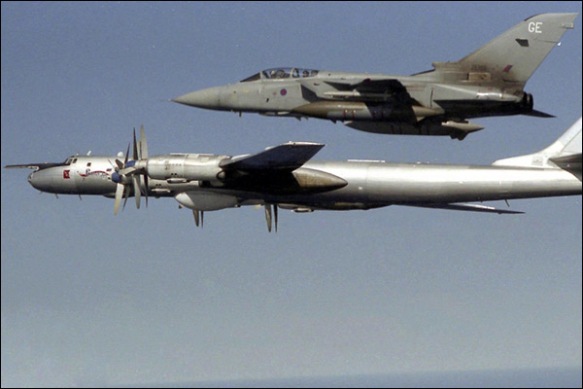
Sidewinder and Skyflash air-to-air missiles arm 25 Sqn Tornado F. 3 ZE808 as it escorts a Russian Navy Tu-142M Bear F Mod 3. With a nose lengthened by 3ft 11in to incorporate a Korshun air-to-surface search/attack radar and an MMS-106 Ladoga MAD boom at the fin tip, this variant is powered by Kuznetsov NK-12MV engines. Generating 14,795shp these remain the most powerful turboprops in the world.
From bases in the north of Russia the giant Tupolev Tu-95/142s, codenamed `Bear’ by NATO, follow well-defined routes round the North Cape and down the Norwegian Sea, sometimes heading south over the North Sea and at other times turning west to reconnoitre the Greenland-Iceland gap.
Over the years Bears have made predicted appearances during western naval exercises, photographing and listening to comms and radar transmissions. The crews communicate with their `bombers’ – the strategic ballistic missile submarines – under the surface via long VLF aerials trailed behind the aircraft and check on the alert status of intercepting fighters and their squadrons.
Sometimes a Bear is observed laying a group of sonobuoys in the ocean to pick up `enemy’ submarines and send data via satellite back to `Moscow Station’. Mission length is variable but eleven hours is typical for which the crew numbers seven.
The crews of the 64 Bears in service and their colleagues in the 15 or so Tu-160 Blackjacks in the Long-Range Bomber Force are now generally friendly, often waving at their fellow aviators from the West, but this was not always the case.
Tactics
At the height of the Cold War when the Soviet Union was considered by US President Ronald Reagan to be `the evil empire’, Soviet pilots could play dangerous games in unrestricted airspace. As related above, they sometimes turned quickly towards their unwanted escort, forcing a quick response away from the mighty slab of metal which suddenly filled the NATO pilot’s vision! At other times, particularly when the rather short-legged Lightning was the UK’s principle interceptor, the cruising Bear pilot would steadily open the throttles and increase speed from 380kts to a very respectable 500kts (Mach 0.83). This in turn forced the accompanying fighter to put on more speed, thus increasing his fuel consumption to the point where he would have to break off contact and seek a tanker or a smart return to base! Such tactics saw the RAF respond by employing a relay of fighters to keep the intruder covered until it turned for home.
The arrival of more versatile fighters like the McDonnell Douglas F-4 Phantom and Panavia Tornado F. 3, long-range fuel tanks and a clutch of suitable air-to-air missiles gave the Quick Reaction Alert (QRA) crews much longer times `on station’ when they met an intruder.
Reinstated
Although these flights were effectively suspended in 1992, following the collapse of Soviet Communism and ever-tighter budgets for the armed forces, by 2007 President Putin had ordered that the new Russia should be seen again in international skies. In August of that year the Bears of the 37th Air Army (Strategic) belonging to the Russian Long-Range Aviation Command returned to their habitual long over-water missions observing foreign forces around the world. With the retirement of the Tornado F. 3s, the much more capable Typhoons have become the RAF’s latest interceptor to keep an eye on the Bears, aircraft which were built before the average British pilot was born! Occasionally, Blackjacks appear but are less common on long, out-of-area missions.
Further afield, the Bear can be found flying from eastern Russia to observe Chinese as well as Japanese and American naval operations around the Pacific Rim.
To date, there is no clear alternative to the Bear for the tasks it performs and its lifetime has yet to draw to a close. Indeed the current plan is for this remarkable aircraft to have a life-extension programme to take it to 2030. Not bad for a design that first flew on November 12, 1952, with engines designed by captured German engineers and based on the Jumo 022 of World War Two! By the time the aircraft finally retires it will be more than eighty years old…